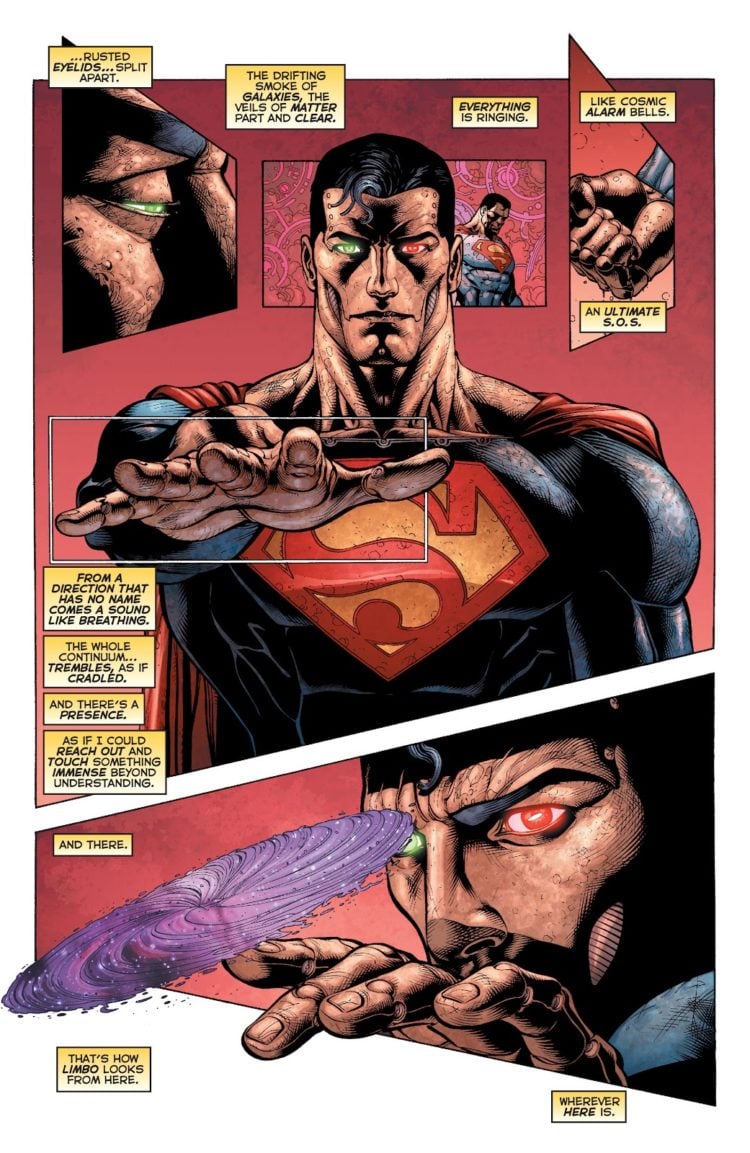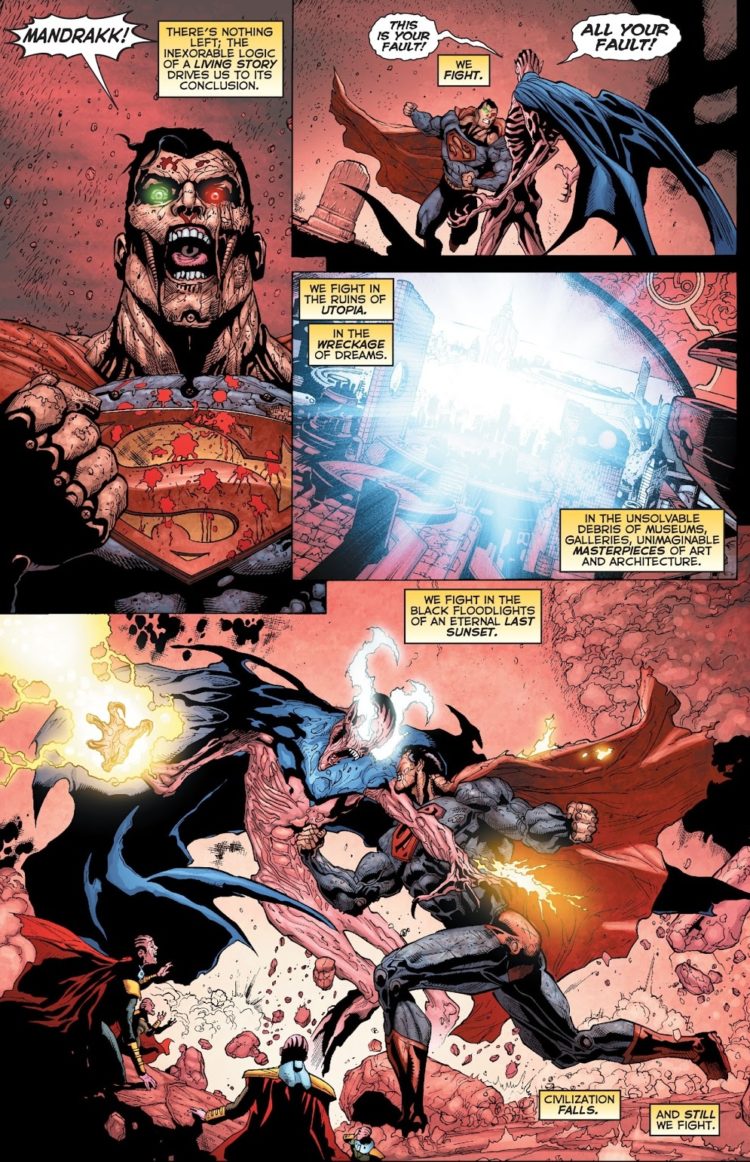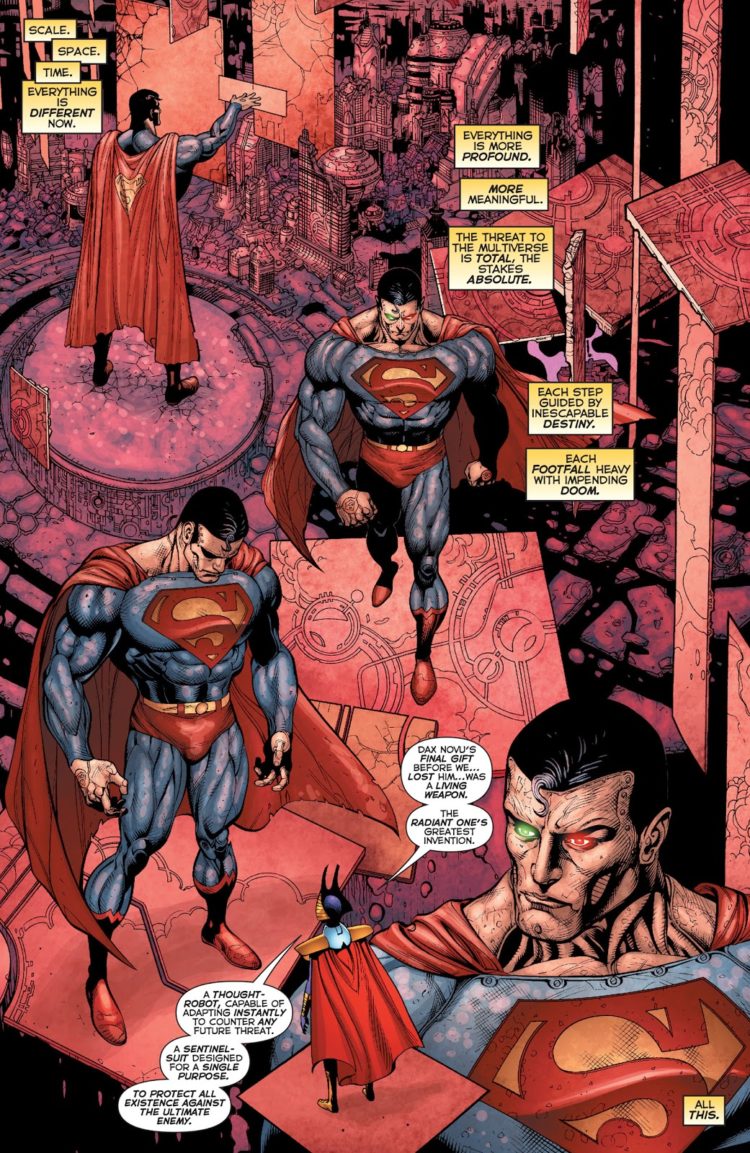
This is a two-part story. The first part covers comic book fiction, ‘Final Crisis’, the Overvoid Monitor and ‘Superman Beyond #1’. The second part covers the Thought Robot, ‘Superman Beyond #2’, ‘Final Crisis’ and Superman’s place in the DC multiverse.
For those who have not read, this article contains spoilers on ‘Final Crisis’ and ‘Superman Beyond #1’ and ‘Superman Beyond #2’.
“Faster than a speeding photon!” (‘JLA: Heaven’s Ladder’) “Flexes to shift the tectonic plates!” “Can hear clouds scrape together!” (Kingdom Come #2) “Strong enough to lift Infinity!” (Superman Beyond #1). “Is it a comet? Is it the Ultima Thule? It’s Superman!”
Superman, the greatest story: The Thought Robot
‘Superman Beyond #2’ marks a significant genesis of a concept central to Grant Morrison: meta-fiction. Here, characters actually are Breaking the Fourth Wall and become the creators of the fictional story.
In ‘Superman Beyond #1’, the Overvoid Monitor states:
“The flaw is sealed, scabbed over. With divine metals!”
The other half of the Monitor’s origin story, and of the origin of multiverse, speaks of “the legend”. It’s here that we are introduced to the Thought Robot. The Thought Robot exists to correct the meta-fictional imbalance of the multiverse as a result of the concept story that demands conflict and opposition between contradictory forces. In the end, it’s to stop against “the ultimate threat”: the erasure of all stories by Mandrakk!
In ‘Superman Beyond #1’, the Overvoid Monitor states:
“Becomes this history of a once-mighty race of hyper gods, direct descendants of the first immense, unknowable monitor!
“This epic elegy of a doomed civilization, declining from splendor to squalor.”
The function of the Thought Robot is revealed in ‘Superman Beyond #2’ where Superman and Ultraman, two opposite and contradictory forces, “dualities” united by “a new fusion process,” are “symmetries” into the Thought Robot, the Superman capable of countering any threat.
As Zillo Valla states in ‘Superman Beyond #2’:
A thought-robot, capable of adapting instantly to counter any future threat. A sentinel-suit designed for a single purpose. To protect all existence against the ultimate enemy.
NIGHT FALLS!

Mandrakk was formerly known as Dax Novu, “the radiant one, the first son of monitor” – a monitor who discovered the DC multiverse, “mapped the flaw” (the story) and blessed the monitors with “knowledge and the riches of bleed.” Dax Novu, a scientist, “wrestled the angel of contamination”, “who gave his life to chain the beast in darkness” became Mandrakk!
In ‘Superman Beyond #2’, comes the ‘Final Crisis’. In ‘Superman Beyond #2’, the Thought Robot states:
Great Krypton. The entire multiverse is the prey of celestial parasites! Vampire gods! Night Falls!
I’M INSIDE A SELF-ASSEMBLING HYPER-STORY!

In ‘Superman Beyond #2’, the Thought Robot is the narrator:
“We fight in the ruins of utopia. In the wreckage of dreams. In the unsolvable debris of museums, galleries, unimaginable masterpieces of art and architecture. We fight in the black floodlights of an eternal, last sunset. Civilization falls. And still we fight.”
The Thought Robot actually reveals an example of Breaking the Fourth Wall. In “the ultimate threat”, the Thought Robot becomes aware of being “inside an assembling hyper-story.” In his interview with IGN, Morrison said that in “an assembling hyper-story”, the concept of dualities collapses before the mind of Overvoid Monitor. Here, everything is driven by the “hyper-story”.
IGN Comics: You get into that in Superman Beyond #2 with the Superman and Ultraman dynamic.
Yeah. Again, on the very edge of the art and the edge of the mind of God there are these two big concepts fighting – Superman and Mandrakk, Predation and Protection, Greed and Preservation, Ugly and Beautiful, Youth and Age, Good and Evil, Black and White, Is and Isn’t and all the others. Beyond that crumbling ledge in Monitor-World, those concepts don’t exist and it’s all non-dual Monitor mind, or God, or Kirby’s Source, in which all contradictions are resolved into unity. It’s funny, the more I talk about it, the more I’m getting into it!
Mandrakk attacks the Thought Robot with “the blood of 52 universes. The heat of ten billion suns” and the Thought Robot fights back, demonstrating berserker strength and reactive evolution to counter the threat.
“The stronger he becomes, the stronger I become to oppose him. And vice versa.”
Here, dualities collapse, and strengthen each other only to be driven by a “hyper-story”. What drives the battle then, is the story of the Thought Robot, of Superman.
“There is nothing left; the inexorable logic of a story drives us to its final conclusion.”
The Thought Robot is revealed by Zillo Valla in ‘Superman Beyond #2’:
“But deep within the germ-worlds, I found a better story: one created to be unstoppable, indestructible! The story of a child rocketed to Earth from a doomed planet…”
To which Mandrakk answers with a bolt of cosmic shock, killing Zillo Valla. Ouch! Ultimately, the story of the Thought Robot drives “a hyper-story” where “night falls”. Precisely, it is the story of the Thought Robot, of Superman that protects against “the ultimate threat”: The erasure of all stories! Would you imagine a world without stories, where there is no passion, no flame, no romance, no conflict?
FINAL CRISIS

Morrison “writes” in ‘Final Crisis’ that Superman is the central figure in the DC multiverse, in its essence, its prototypical “good guy”.
IGN Comics: So if you’d go so far as to say the DC Multiverse is as real and as organic as anything, would you say that the story of Superman is its heart?
Yeah, totally. Because it all derived from Superman. I mean, I love all the characters, but Superman is just this perfect human pop-culture distillation of a really basic idea. He’s a good guy. He loves us. He will not stop in defending us. How beautiful is that? He’s like a sci-fi Jesus. He’ll never let you down. And only in fiction can that guy actually exist, because real guys will always let you down one way or another. We actually made up an idea that beautiful. That’s just cool to me. We made a little paper universe where all of the above is true.
The Thought Robot figures as a meta-fictional commentary on this “sci-fi Jesus.” It is the central concept, the “story” that unites all the “dualities” in the DC multiverse beyond the 4D “hyper-space” of the Bleed, the connective tissue that unites all of DC multiverse fictional continuity.
It all boils down to this: The Thought Robot is the central “story”! A central “story” that traverses through DC comics continuity since he protects against “the ultimate threat”! Grant Morrison seems to be saying that beyond the cynicism and the darkness of ‘Final Crisis’, the crossover storyline is ultimately about the story of Superman, heightened to the Monitor World, “at the edge of art” as the Thought Robot. This is mind-boggling!
We are saying that The Thought Robot is the sufficient account for the DC multiverse: its hope! Without hope, there are no stories. And no character embodies hope more than Superman. The first superhero! Great Krypton!
If we take our pen and write, we may say that the Thought Robot is the greatest story that created not only the DC multiverse, the Outerversal Overvoid Monitor, but also, the whole genre of comic book fiction, the whole medium, the white canvas of comic book fiction – here, the Overvoid Monitor figures as the artistic medium through which the process of comic book creation takes place – regardless of the comic book company. It is a claim, that, DC created Marvel – and all the other comic book companies – and Superman created all the superheroes.
And so, when the Overvoid Monitor originally is unable to comprehend the concept “story” in ‘Superman Beyond #1’, it is “the legend” of the Thought Robot that safeguards him from the concept “story” – in other words, “the legend” of the Thought Robot protects the DC multiverse.
As Morrison said in the interview in response to a question and I reiterate his answer:
Yeah, totally. Because it all derived from Superman. I mean, I love all the characters, but Superman is just this perfect human pop-culture distillation of a really basic idea. He’s a good guy.
MANDRAKK IS THE OPPOSITE OF LIFE

In ‘Superman Beyond #2’, the Thought Robot states:
“Mandrakk is the opposite of life.”
The Thought Robot is the hope of the DC multiverse and in the protection of stories resides that hope: to counter any threat, to Break the Fourth Wall, to prevent the story from being written by the wrong hands. To hold back the forces of Death, the nihilism of Chaos.
The thought of Lois and the death of Zillo Valla are the reminders from Ultraman – united to the Thought Robot – that ultimately, is the protection of life that is the essence of Superman.
It stands clear when the moment is most poignant: The Thought Robot is the story, “the legend” that cannot be erased by the mind of the Overvoid Monitor. In the end, Superman defeats the foe! Superman wins! (Was it ever in doubt?) Mandrakk is sent back into the void, into the Overvoid “until even the idea of him is lost.”
I can hear him, still screaming all the way down, down, down, until even the idea of him is lost.
Until the Overvoid, the mind of Monitor, engulfs him…
…Already forgetting.
The Thought Robot recovers the Ultramenstruum and Superman saves Lois’ life. Yup yup!
Superman’s story is the greatest story!
The story of the Thought Robot continues with an epitaph:

Source: DC Universe
